Lotus Notes User Id Has Not Been Uploaded to Notes Id Vault
This browser is no longer supported.
Upgrade to Microsoft Edge to take advantage of the latest features, security updates, and technical support.
Lotus Domino Connector technical reference
This commodity describes the Lotus Domino Connector. The commodity applies to the following products:
- Microsoft Identity Manager 2016 (MIM2016)
- Forefront Identity Managing director 2010 R2 (FIM2010R2)
- Must use hotfix iv.1.3671.0 or later.
For MIM2016 and FIM2010R2, the Connector is available as a download from the Microsoft Download Center.
Overview of the Lotus Domino Connector
The Lotus Domino Connector enables you to integrate the synchronization service with IBM's Lotus Domino server.
From a high-level perspective, the following features are supported by the electric current release of the connector:
| Feature | Support |
|---|---|
| Connected data source | Server: |
| Scenarios | |
| Operations | |
| Schema | |
The Lotus Domino connector uses the Lotus Notes customer to communicate with Lotus Domino Server. As a upshot of this dependency, a supported Lotus Notes Customer must be installed on the synchronization server. The communication betwixt the client and the server is implemented through the Lotus Notes .NET Interop (Interop.domino.dll) interface. This interface facilitates the communication between the Microsoft.NET platform and Lotus Notes customer and supports admission to Lotus Domino documents and views. For delta import, it is also possible that the C++ native interface is used (depending on the selected delta import method).
Prerequisites
Before yous use the Connector, make sure you have the following prerequisites on the synchronization server:
- Microsoft .NET 4.v.two Framework or later
- The Lotus Notes client must exist installed on your synchronization server
- The Lotus Domino Connector requires the default Lotus Domino LDAP schema database (schema.nsf) to exist present on the Domino Directory server. If it is non present, you tin can install it by running or restarting the LDAP service on the Domino server.
Deploying this connector may crave customization of your Lotus Domino server. For deployments involving integrating MIM with Domino in a production surround, we recommend customers work with a deployment partner for assistance, guidance, and support for this integration.
Connected Data Source permissions
To perform any of the supported tasks in Lotus Domino connector, you must be a member of following groups:
- Total Admission administrators
- Administrators
- Database Administrators
The following tabular array lists the permissions that are required for each operation:
| Functioning | Access Rights |
|---|---|
| Import | |
| Export and Set Countersign | Constructive Admission: |
Direct operations and AdminP
Operations either get directly to the Domino directory or through the AdminP process. The following tables list all supported objects, operations and, if applicative, the related implementation method:
Chief Address Book
| Object | Create | Update | Delete |
|---|---|---|---|
| Person | AdminP | Direct | AdminP |
| Group | AdminP | Direct | AdminP |
| MailInDB | Straight | Direct | Direct |
| Resources | AdminP | Directly | AdminP |
Secondary Address Book
| Object | Create | Update | Delete |
|---|---|---|---|
| Person | N/A | Straight | Direct |
| Grouping | Direct | Direct | Directly |
| MailInDB | Direct | Direct | Straight |
| Resource | N/A | N/A | N/A |
When a resources is created, a Notes certificate is created. Similarly, when a resources is deleted, the Notes document is deleted.
Ports and protocols
IBM Lotus Notes client and Domino servers communicate using Notes Remote Process Call (NRPC) where NRPC should utilise TCP/IP. The default port number is 1352, but tin be changed past the Domino administrator.
Not supported
The following operations are not supported by the current release of the Lotus Domino connector:
- Motion mailbox between servers.
Create a new Connector
Client Software Installation and Configuration
Lotus Notes must exist installed on the server earlier the Connector is installed.
When you install, make sure yous do a Single User Install. The default Multi-User Install does not work.
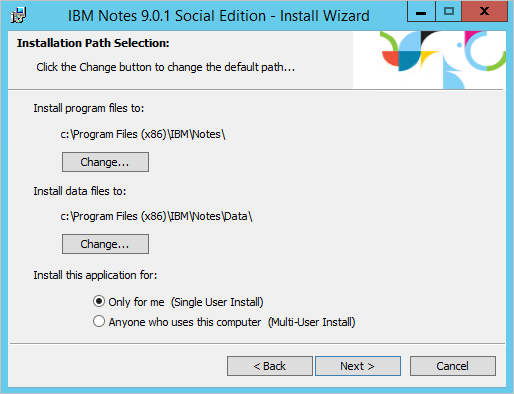
On the features folio, install only the required Lotus Notes features and Client Single Logon. Unmarried Logon is required for the connector to be able to log on to the Domino server.
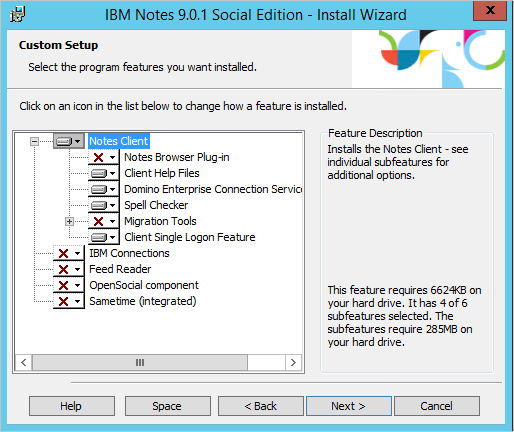
Note: Offset Lotus Notes once with a user that is located on the same server as the business relationship you use as the connector's service account. Also brand sure to close the Lotus Notes client on the server. It cannot be running at the same time the Connector tries to connect to the Domino server.
Create Connector
To Create a Lotus Domino connector, in Synchronization Service select Management Agent and Create. Select the Lotus Domino (Microsoft) Connector.
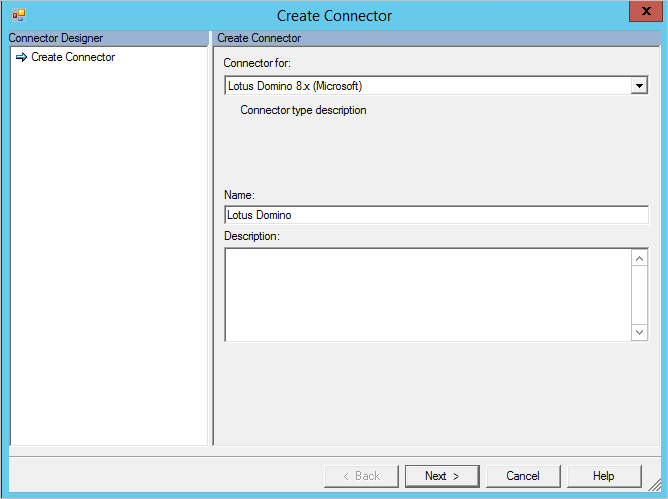
If your version of synchronization service offers the power to configure Compages, make sure the connector is prepare to its default value to run in Procedure.
Connectivity
On the Connectivity page, you lot must specify the Lotus Domino server name and enter the logon credentials.

The Domino Server holding supports 2 formats for the server proper noun:
- ServerName
- ServerName/DirectoryName
The ServerName/DirectoryName format is the preferred format for this attribute because it provides faster response when the connector contacts the Domino Server.
The provided UserID file is stored in the configuration database of the synchronization service.
For Delta Import you accept these options:
- None. The Connector does not practise any delta imports.
- Add together/Update. The Connector does delta import add and update operations. For delete, a Full Import operation is required. This functioning is using the .NET interop.
- Add/Update/Delete. The Connector does delta import add together, update, and delete operations. This operation is using the native C++ interfaces.
In Schema Options you accept the following options:
- Default Schema. The Connector detects the schema from the Domino server. This pick is the default selection.
- DSML-Schema. Only used if the Domino server does not betrayal the schema. Then you can create a DSML file with the schema and import it instead. For more than information on DSML, meet Oasis.
When you click Next, the UserID and password configuration parameters are verified.
Global Parameters
On the Global Parameters page, you configure the fourth dimension zone and the import and export operation choice.
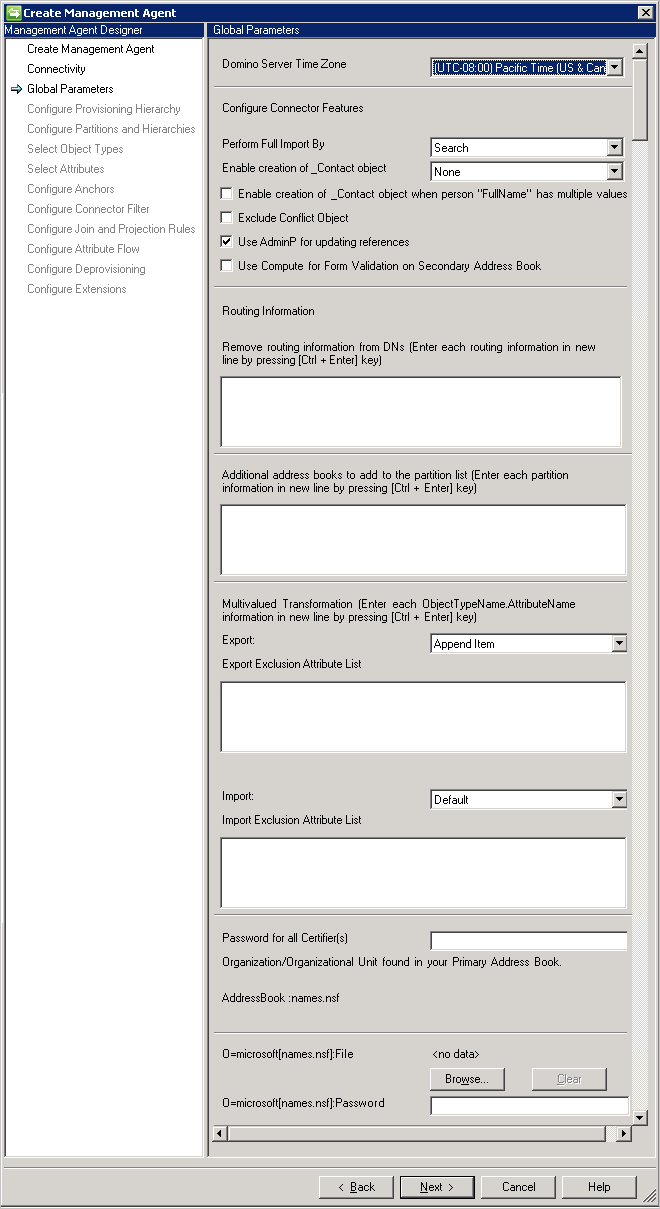
The Domino Server Fourth dimension Zone parameter defines the location of your Domino Server.
This configuration selection is required to back up delta import operations because information technology enables the synchronization service determine changes between the last two imports.
Note
Starting in the March 2017 update the Global parameters screen includes the option to delete the user'south mail service database during the user's deletion.
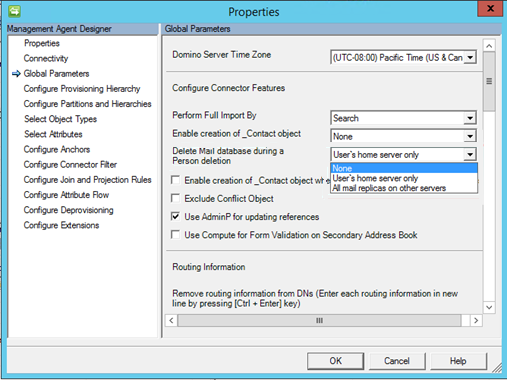
Import settings, method
The Perform Full Import By has these options:
- Search
- View (Recommended)
Search is using indexing in Domino but it is common that the indexes are non updated in real time and the data returned from the server is non ever correct. For a arrangement with many changes, this option usually doesn't piece of work well and provides false deletes in some situations. However, search is faster than view.
View is the recommended pick since it provides the right state of data. It is slightly slower than search.
Creation of Virtual Contact Objects
The Enable creation of _Contact object has these options:
- None
- Not-Reference Values
- Reference and Non-Reference Values
In Domino, reference attributes tin comprise many different formats to reference other objects. To be able to correspond dissimilar variations, the Connector implements _Contact objects, besides known as Virtual Contacts (VC). These objects are created and then they tin can join to existing MV objects or projected as new objects. In this way, attribute references tin can be preserved.
By enabling this setting and if the content of a reference aspect is not a DN format, a _Contact object is created. For case, a fellow member aspect of a grouping tin can comprise SMTP addresses. It is also possible to have shortName and other attributes present in reference attributes. For this scenario, select Non-Reference Values. This configuration is the nigh common setting for Domino implementations.
When Lotus Domino is configured to accept split up accost books with different distinguished names representing the same object, it's possible to also create _Contact objects for all reference values that are found in an address volume. For this scenario, select the Reference and Non-Reference Values option.
If you have multiple values in the aspect FullName in Domino, and so you also want to enable the cosmos of Virtual Contacts so references tin be resolved. For example, this attribute tin have multiple values after a marriage or divorce. Select the checkbox Enable ... FullName has multiple values for this scenario.
By joining on the correct attributes, the _Contact objects would be joined to the MV object.
These objects have VC=_Contact added to their DN.
Import settings, conflict object
Exclude Conflict Object
In a big Domino implementation, it is possible that multiple objects have the same DN due to replication issues. In these cases, the connector would see two objects with dissimilar UniversalIDs but aforementioned DN. This conflict would cause a transient object being created in the connector infinite. The Connector can ignore the objects that have been selected in Domino as replication victims. The recommendation is to keep this checkbox selected.
Export settings
If the choice Use AdminP for updating references is unselected, then export of reference attributes, such as member, is a direct call and does not apply the AdminP process. Only use this choice when AdminP has not been configured to maintain referential integrity.
Routing Information
In Domino, it is possible that a reference aspect has routing data embedded every bit a suffix to the DN. For example, the member aspect in a group could incorporate CN=case/organization@ABC. The suffix @ABC is the routing information. The routing information is used by Domino to transport emails to the correct Domino system, which could be a organization in a different organization. In the Routing Information field, you can specify the routing suffixes used within the organization in scope of the Connector. If one of these values is establish as a suffix in a reference attribute, the routing information is removed from the reference. If the routing suffix on a reference value cannot exist matched to 1 of those values specified, a _Contact object is created. These _Contact objects are created with RO=@<RoutingSuffix> inserted into the DN. For these _Contact objects the following attributes are also added to permit joining to a real object if necessary: _routingName, _contactName, _displayName, and UniversalID.
Additional address books
If you do not take directory assistance installed, which provides the name of secondary accost books, then you can manually enter these address books.
Multivalued Transformation
Many attributes in Lotus Domino are multi-valued. The corresponding metaverse attributes are typically single valued. By configuring the Import and the Consign operation option, you lot enable the connector to help with the required translation of the affected attributes.
Consign
The Export operation option supports two modes:
- Append particular
- Replace item
Replace Item – When you select this option, the connector always remove the current values of the attribute in Domino and replace them with the provided values. The provided valued can be either single-valued or multi-valued.
Case: The Assistant aspect of a person object has the post-obit values:
- CN=Greg Winston/OU=Contoso/O=Americas,NAB=names.nsf
- CN=John Smith/OU=Contoso/O=Americas,NAB=names.nsf
If a new Assistant named David Alexander is assigned to this person object, the result is:
- CN=David Alexander/OU=Contoso/O=Americas,NAB=names.nsf
Suspend Item – When you select this option, the connector retains the existing values on the attribute in Domino and insert new values at the top of the information list.
Example: The Assistant attribute of a person object has the following values:
- CN=Greg Winston/OU=Contoso/O=Americas,NAB=names.nsf
- CN=John Smith/OU=Contoso/O=Americas,NAB=names.nsf
If a new Assistant named David Alexander is assigned to this person object, the result is:
- CN=David Alexander/OU=Contoso/O=Americas,NAB=names.nsf
- CN=Greg Winston/OU=Contoso/O=Americas,NAB=names.nsf
- CN=John Smith/OU=Contoso/O=Americas,NAB=names.nsf
Import
The Import operation pick supports two modes:
- Default
- Multivalued to Single Value
Default – When you select the Default option, all values of all the attributes are imported.
Multivalued to Single Value – When you select this option, a multi-valued attribute is converted into a single-valued attribute. If more ane value exists, the value on the elevation (this value is typically also the latest) is used.
Example: The Assistant attribute of a person object has the following values:
- CN=David Alexander/OU=Contoso/O=Americas,NAB=names.nsf
- CN=Greg Winston/OU=Contoso/O=Americas,NAB=names.nsf
- CN=John Smith/OU=Contoso/O=Americas,NAB=names.nsf
The most recent update to this attribute is David Alexander. Considering the Import operation option is prepare to Multivalued to Unmarried Value, connector only imports David Alexander into the connector space.
The logic to convert multi-valued attributes into unmarried-valued attributes does non apply to the group fellow member attribute and to the person fullname aspect.
It as well possible to configure import and export transformation rules for multivalued attributes per attribute, as an exception to the global rule. To configure this option, enter [objecttype].[attributename] in the import exclusion attribute list and export exclusion attribute list text boxes. For example, if you enter Person.Assistant and the global flag is set to import all values, only the first value is imported for the assistant.
Certifiers
All Organization/Organizational Units are listed by the connector. To be able to export person objects to the primary accost book, a certifier with its countersign is required.
If all certifiers have the same password, the Password for all Certifiers can exist used. Then you tin enter the password here and only specify the certifier file.
If you but import, then yous practise not have to specify whatever certifiers.
Configure Provisioning Hierarchy
When you configure the Lotus Domino connector, skip this dialog folio. The Lotus Domino connector does not support hierarchy provisioning.
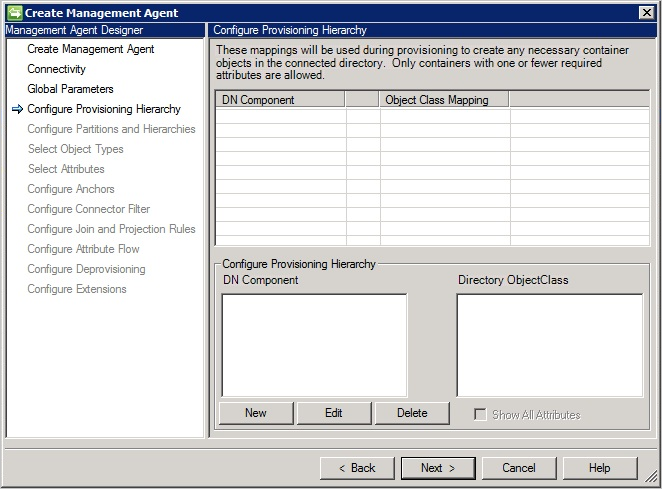
Configure Partitions and Hierarchies
When you configure partitions and hierarchies, you must select the primary accost book called NAB=names.nsf. In addition to the primary address volume, you can select secondary address books if they exist.

Select Attributes
When you configure your attributes, you must select all attributes that are prefixed with _MMS_. These attributes are required when you provision new objects to Lotus Domino

Object Lifecycle Management
This section provides an overview of the dissimilar objects in Domino.
Person Objects
The person object represents users in Organisation and Organization Units. In addition to the default attributes, the Domino administrator tin can add custom attributes to a Person object. At a minimum, a Person object must include all mandatory attributes. For a complete listing of mandatory attributes, run into Lotus Notes Backdrop. To register a person object, the following prerequisites must be met:
- The accost book (names.nsf) must have been defined and it should be the main address book.
- You must have the O/OU certifier Id and the password to annals a item user in the Organization / Organization Unit.
- You must ready a specific fix of Lotus Notes properties for a person object. These properties are used for provisioning the person object. For more information, see the section called Lotus Notes Properties later in this document.
- The initial HTTP countersign for a person is an attribute and prepare during provisioning.
- The person object must be one of the post-obit three supported types:
- Normal User that has a mail file and a user id file
- Roaming User (a Normal User that includes all roaming database files)
- Contacts (user with no id file)
Persons (except contacts) can farther be grouped into US Users and International Users as divers by the value of the _MMS_IDRegType property. These people employ the Notes Client to access Lotus Domino servers, have a Notes Id, and a Person document. If they are using Notes mail service, then they also take a mail file. The user must be registered to become active. For more information, encounter:
- Setting up Notes users, previously at
https://www.ibm.com/support/knowledgecenter/SSKTMJ_8.5.3/com.ibm.help.domino.admin85.doc/H_SETTING_UP_NOTES_USERS.html - User Registration, previously at
https://www.ibm.com/support/knowledgecenter/SSKTMJ_8.5.3/com.ibm.assist.domino.admin85.doctor/H_REGISTERING_USERS.html - Managing users, previously at
https://www.ibm.com/support/knowledgecenter/SSKTMJ_8.5.3/com.ibm.help.domino.admin85.doc/H_MANAGING_USERS_5151.html - Renaming users, previously at
https://world wide web.ibm.com/support/knowledgecenter/SSKTMJ_8.5.3/com.ibm.help.domino.admin85.physician/H_RENAMING_A_LOTUS_INOTES_USER_STEPS.html
All these operations are performed in Lotus Domino so imported into the synchronization service.
Resources and Rooms
A Resource is another type of a database in Lotus Domino. Resource can be conference rooms with various types of equipment, such as projectors. There are subtypes of resource supported by Lotus Domino connector that are defined past the Resource Type attribute:
| Type of Resource | Resources Blazon Attribute |
|---|---|
| Room | ane |
| Resource (Other) | 2 |
| Online Coming together | 3 |
For the Resources object blazon to work, the following is required:
- Resource Reservation database should already be in the continued Domino server
- The site is already divers for the Resource
The Resource Reservation database contains three types of documents:
- Site Profile
- Resource
- Reservation
For more information on setting upward of Resources Reservation database, see Setting up the Resources Reservations database, previously at https://www-01.ibm.com/support/knowledgecenter/SSKTMJ_8.0.1/com.ibm.help.domino.admin.md/Physician/H_SETTING_UP_THE_RESOURCE_RESERVATIONS_DATABASE.html.
Create, Update, and Delete Resources
The Create, Update, and Delete operations are performed by the Lotus Domino connector in the Resource Reservation database. Resource are created as documents in Names.nsf (that is, the primary accost book). For more than information about editing and deleting Resources, meet Editing and deleting Resource documents, previously at https://www.ibm.com/support/knowledgecenter/SSKTMJ_8.v.3/com.ibm.assistance.domino.admin85.doc/H_EDITING_AND_DELETING_RESOURCE_DOCUMENTS.html.
Import and Export operation for Resource
The Resource can be imported to and exported from the synchronization service, similar any other object type. Select the object type as Resources during configuration. For successful export operation, you should have details for Resource blazon, Conference Database, and Site name.
Mail-In Databases
A Mail-In Database is a database that is designed to receive mails. It is a Lotus Domino mailbox that is not associated with any specific Lotus Domino user account (that is, it does non accept its own ID file and password). A postal service-in database has a unique UserID ("brusque name") associated with it and its own e-post accost.
If there is a need for a separate mailbox with its own e-mail address that can exist shared among different users (for example, group@contoso.com), a mail-in database is created. The access to this mailbox is controlled through its Access Control List (ACL), which contains the names of the Notes users that are allowed to open up the mailbox.
For a list of the required attributes, meet the section called Mandatory Attributes afterward in this commodity.
When a database is designed to receive a postal service, a Mail-In Database certificate is created in Lotus Domino. This document must exist in Domino Directory of every server that stores a copy of the database. For a detailed description well-nigh creating a mail service-in database document, run across Creating a Mail-In Database document, previously at https://world wide web.ibm.com/support/knowledgecenter/SSKTMJ_8.v.iii/com.ibm.assist.domino.admin85.doc/H_CREATING_A_MAILIN_DATABASE_DOCUMENT_FOR_A_NEW_DATABASE_OVERVIEW.html.
Before creating a Post-In Database, the database should already exist (should have been created past Lotus Admin) at the Domino server.
Grouping Direction
You tin can become a detailed overview of the Lotus Domino group management from the following resource:
- Using groups, previously at
https://www.ibm.com/support/knowledgecenter/SSKTMJ_8.5.3/com.ibm.help.domino.admin85.doc/H_USING_GROUPS_OVER.html - Creating a grouping, previously at
https://www.ibm.com/support/knowledgecenter/SSKTMJ_8.5.3/com.ibm.assistance.domino.admin85.doc/H_CREATING_AND_MODIFYING_GROUPS_STEPS_MIDTOPIC_55038956829238418.html - Creating and modifying groups, previously at
https://www.ibm.com/back up/knowledgecenter/SSKTMJ_8.5.iii/com.ibm.assistance.domino.admin85.doc/H_CREATING_AND_MODIFYING_GROUPS_STEPS.html - Managing groups, previously at
https://world wide web.ibm.com/support/knowledgecenter/SSKTMJ_8.5.3/com.ibm.help.domino.admin85.doc/H_MANAGING_GROUPS_1804.html - Renaming a group, previously at
https://www.ibm.com/support/knowledgecenter/SSKTMJ_8.5.3/com.ibm.help.domino.admin85.dr./H_RENAMING_A_GROUP_STEPS.html
Password Management
For a registered Lotus Domino user, in that location are two types of passwords:
- User password (Stored in User.id file)
- Internet / HTTP password
The Lotus Domino connector supports simply operations with HTTP countersign.
To perform password direction, yous should enable password management for the connector in the Management Agent Designer. To enable password management, select Enable countersign management on the Configure Extensions dialog page.
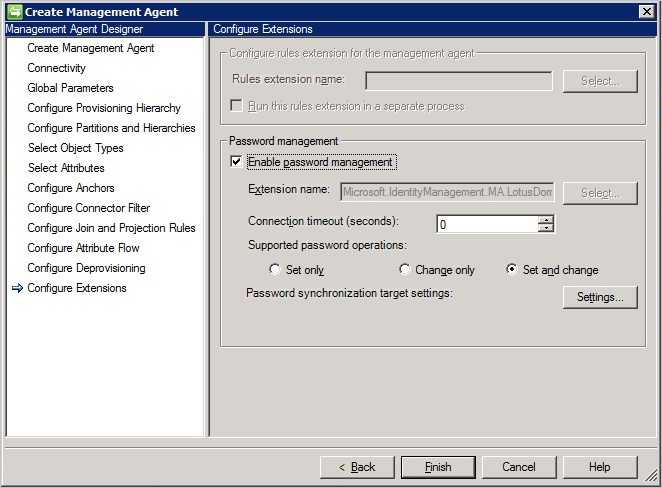
The Lotus Domino connector back up following operations on Net password:
- Set Password: Set password sets a new HTTP/Cyberspace password on the user in Domino. By default the business relationship is as well unlocked. The unlock flag is exposed on the WMI interface of the Sync Engine.
- Change Countersign: In this scenario, a user might want to change the password or is prompted to change password after a specified time. For this operation to accept identify, both (the old and the new password) are mandatory. Once changed, the new countersign is updated in Lotus Domino.
For more than information, see:
- Using the Internet lockout characteristic
- Managing Internet passwords, previously at
https://www.ibm.com/back up/knowledgecenter/SSKTMJ_8.5.3/com.ibm.help.domino.admin85.doc/H_NOTES_AND_INTERNET_PASSWORD_SYNCHRONIZATION_7570_OVER.html
Reference Data
This section lists such as attribute descriptions and attribute requirements for the Lotus Domino connector.
Lotus Notes Properties
When you provision Person objects to your Lotus Domino directory, your objects must accept a specific set of properties with specific values populated. These values are simply required for Create operations.
The following table lists these backdrop and provides a clarification of them.
| Property | Clarification |
|---|---|
| _MMS_AltFullName | The alternate full proper name of user. |
| _MMS_AltFullNameLanguage | The language to be used for specifying the alternating full name of user. |
| _MMS_CertDaysToExpire | The number of days from the current date before the document expires. If non specified, the default date is ii years from the electric current date. |
| _MMS_Certifier | Holding that contains the organizational hierarchy name of the certifier. For Case: OU=OrganizationUnit,O=Org,C=Land. |
| _MMS_IDPath | If the property is empty, no user identification file is created locally on the Sync Server. If the property contains a file name, a user ID file is created in the madata binder. The holding can as well contain a full path. |
| _MMS_IDRegType | Persons can be classified equally contacts, U.s.a. Users, and international Users. The following table lists the possible values: |
| _MMS_IDStoreType | Required property for U.South. and international users. The belongings contains an integer value that specifies whether the user identification is stored as an zipper in the Notes accost book or in the person's mail file. If the User ID file is an attachment in the address book, it tin optionally be created as a file with _MMS_IDPath. |
| _MMS_MailQuotaSizeLimit | The number of megabytes that are immune for the e-mail service file database. |
| _MMS_MailQuotaWarningThreshold | The number of megabytes that are allowed for the email file database before a warning is issued. |
| _MMS_MailTemplateName | The due east-mail service template file that is used to create the user's e-post file. If a template is specified, the mail file is created using the specified template. If no template is specified, the default template file is used to create the file. |
| _MMS_OU | Optional property that is the OU proper noun under the certifier. This property should be empty for contacts. |
| _MMS_Password | Required property for users. The property contains the password for the identification file of the object. |
| _MMS_UseAdminP | Holding should be ready to truthful if the mail file should be created by the AdminP process on the Domino server (asynchronous to the export process). If property is fix to false, the postal service file is created with the Domino user (synchronous in the export process). |
For a user with an associated identification file, the _MMS_Password holding must contain a value. For electronic mail access through the Lotus Notes client, the MailServer and MailFile properties of a user must comprise a value.
To access electronic mail through a Web browser, the following properties must contain values:
- MailFile - Required property that contains the path on the Lotus Domino server where the postal service file is stored.
- MailServer - Required property that contains the proper noun of the Lotus Domino server. This value is the name to apply when you created the Lotus postal service file on the Domino server.
- HTTPPassword - Optional property that contains the Web access countersign for the object.
To access the Domino Server without mail adequacy, the HTTPPassword belongings must contain a value. The MailFile property and the MailServer holding can be empty.
With _MMS_ IDStoreType = two (store id in Mail file), the MailSystem property of NotesRegistrationclass is set to REG_MAILSYSTEM_INOTES (three).
Mandatory Attributes
The Lotus Domino connector mainly supports these types of objects (document types):
- Group
- Mail-In Database
- Person
- Contact (Person with no certifier)
- Resource
This section lists the attributes that are mandatory for each supported object to export to a Domino server.
| Object Type | Mandatory Attributes |
|---|---|
| Grouping | |
| Principal-In Database | |
| Person | |
| Contact (Person with no certifier) | |
| Resource | |
Common issues and questions
Schema detection does not work
To be able to detect the schema, it is necessary that the schema.nsf file is present on the Domino server. This file only appears if LDAP is installed on the server. If the schema is non detectable, verify the post-obit:
- The file schema.nsf is present at the root folder of the Domino Server
- The user has permissions to meet the schema.nsf file.
- Force a restart of the LDAP server. Open Lotus Domino Panel and use Tell LDAP ReloadSchema command to reload the schema.
Not all secondary address books are visible
The Domino Connector relies on the characteristic Directory Assistance to be able to find the secondary address books. If the secondary accost books are missing, verify if Directory Assistance, previously at https://world wide web.ibm.com/support/knowledgecenter/SSKTMJ_8.5.three/com.ibm.aid.domino.admin85.dr./H_ABOUT_DIRECTORY_ASSISTANCE.html has been enabled and configured on the Domino Server.
Custom attributes in Domino
At that place are several means in Domino to extend the schema then it appears as a custom attribute consumable by the Connector.
Approach ane: Extend Lotus Domino schema
- Create a re-create of Domino Directory Template {PUBNAMES.NTF} by post-obit these steps, previously at
https://www.ibm.com/support/knowledgecenter/SSKTMJ_8.5.three/com.ibm.help.domino.admin85.doc/H_CREATING_A_COPY_OF_THE_DEFAULT_PUBIC_ADDRESS_BOOK_TEMPLATE.html(you should not customize the default IBM Lotus Domino directory Template): - Open up the Re-create of Domino directory template {CONTOSO.NTF} template that was created in Domino Designer and follow these steps:
- Click Shared Elements and expand Subforms
- Double-click ${ObjectName}InheritableSchema subform (where {ObjectName} is the name of the default structural object class, for example: Person).
- Proper name the attribute y'all want to add into schema {MyPersonAtrribute} and corresponding to that aspect. Create a field past select the Create Bill of fare and and then select Field from menu.
- In the added field, set up its properties by selecting its Type, Style, size, font, and other related parameters on field Properties window.
- Go along the aspect Default value same as the name given for that aspect (For example, if attribute proper name is MyPersonAttribute, keep the default value with the same name).
- Save the ${ObjectName}InheritableSchema subform with updated values.
- Supercede the Domino Directory Template {PUBNAMES.NTF} with the new customized template {CONTOSO.NTF} past following these steps, previously at
https://www.ibm.com/support/knowledgecenter/SSKTMJ_8.v.three/com.ibm.assistance.domino.admin85.doctor/H_ABOUT_RULES_FOR_CUSTOMIZING_THE_PUBLIC_ADDRESS_BOOK.html. - Shut Domino Admin and open up Domino Console to restart the LDAP service and to Reload the LDAP Schema:
- In Domino Console, insert the control nether Domino Command text filed to restart the LDAP service - Restart Job LDAP, previously at
https://www.ibm.com/support/knowledgecenter/SSKTMJ_10.0.ane/admin/conf_startingandstoppingtheldapservice_c.html. - To reload LDAP schema utilise Tell LDAP command - Tell LDAP ReloadSchema
- In Domino Console, insert the control nether Domino Command text filed to restart the LDAP service - Restart Job LDAP, previously at
- Open Domino Admin and select People & Groups tab to come across added attribute is reflected in domino Add Person.
- Open Schema.nsf from Files tab and run across added attribute is reflected into dominoPerson LDAP object class.
Arroyo 2: Create an auxClass with custom aspect and acquaintance with the object class
- Create a copy of Domino Directory Template {PUBNAMES.NTF} by following these steps, previously at
https://www.ibm.com/support/knowledgecenter/SSKTMJ_8.v.3/com.ibm.help.domino.admin85.doc/H_CREATING_A_COPY_OF_THE_DEFAULT_PUBIC_ADDRESS_BOOK_TEMPLATE.html(Never customize the default IBM Lotus Domino directory Template): - Open the Re-create of Domino directory template {CONTOSO.NTF} template that was created, in Domino Designer.
- In the left pane, select Shared Code and so Subforms.
- Click New Subform
- Do the following to specify the properties for the new subform:
- With the new subform open up, cull Design - Subform Properties
- Next to the Proper name property, enter a name for the auxiliary object class -- for example, TestSubform.
- Go along the Options property "Include in Insert Subform... dialog" selected
- Deselect the Options belongings "Return pass through HTML in Notes."
- Get out the other backdrop the same, and shut the Subform Properties box.
- Save and close the new subform.
- Practise the post-obit to add a field to define the auxiliary object class:
- Open the subform you lot created.
- Choose Create - Field.
- Next to Proper name on the Basics tab of the Field dialog box, specify whatsoever name, for case: {MyPersonTestAttribute}.
- In the added field, fix its properties past selecting its Type, Style, size, font, and related properties.
- Keep the attribute Default value same every bit the name given for that attribute (For example, if attribute name is MyPersonTestAttribute, continue the default value with the same name).
- Save the subform with updated values and do the post-obit:
- In the left pane, select Shared Code then Subforms
- Select the new subform, and cull Blueprint - Design Properties.
- Click the third tab from the left, and select Propagate this prohibition of blueprint modify.
- Open ${ObjectName}ExtensibleSchema subform, (where {ObjectName} is the name of the default structural object class, for example – Person).
- Insert Resources and select the Subform (that you lot created, for instance – TestSubform) and save the ${ObjectName}ExtensibleSchema subform.
- Replace the Domino Directory Template {PUBNAMES.NTF} with the new customized template {CONTOSO.NTF} past post-obit these steps, previously at
https://www.ibm.com/support/knowledgecenter/SSKTMJ_8.5.iii/com.ibm.aid.domino.admin85.doc/H_ABOUT_RULES_FOR_CUSTOMIZING_THE_PUBLIC_ADDRESS_BOOK.html. - Close Domino Admin and open Domino Console to restart the LDAP service and to Reload the LDAP Schema:
- In Domino Console, insert the command under Domino Command text filed to restart the LDAP service - Restart Task LDAP, previously at
https://world wide web.ibm.com/support/knowledgecenter/SSKTMJ_10.0.1/admin/conf_startingandstoppingtheldapservice_c.html. - To reload LDAP schema employ Tell LDAP command Tell LDAP ReloadSchema.
- In Domino Console, insert the command under Domino Command text filed to restart the LDAP service - Restart Task LDAP, previously at
- Open Domino Admin and select People & Groups tab to come across added attribute is reflected in domino Add Person (under Others tab).
- Open Schema.nsf from Files tab and see added attribute is reflected under TestSubform LDAP Auxiliary object form.
Approach 3: Add the custom attribute to the ExtensibleObject class
- Open up {Schema.nsf} file placed on the root directory
- Select LDAP Object Classes from the left menu nether All Schema Documents and click Add Object grade button:
- Provide LDAP Name in the class of {zzzExtensibleSchema} (where zzz is the name of the default structural object class, for case Person). For example, to extend the schema for Person object class, provide LDAP name {PersonExtensibleSchema}.
- Provide Superior Object class name, for which yous want to extend the schema. For example, to extend the schema for Person object class, provide Superior Object class proper name {dominoPerson}:
- Provide a valid OID corresponding to the object course.
- Select Extended/custom attributes nether Mandatory or Optional Attribute Types fields as per the requirement:
- Later on adding required attributes to the ExtensibleObjectClass, click Save & Close.
- An ExtensibleObjectClass is created for respective default object grade with extended attributes.
Troubleshooting
- For information on how to enable logging to troubleshoot the connector, run across the How to Enable ETW Tracing for Connectors.
Feedback
Submit and view feedback for
Source: https://docs.microsoft.com/en-us/microsoft-identity-manager/reference/microsoft-identity-manager-2016-connector-domino
0 Response to "Lotus Notes User Id Has Not Been Uploaded to Notes Id Vault"
Enviar um comentário